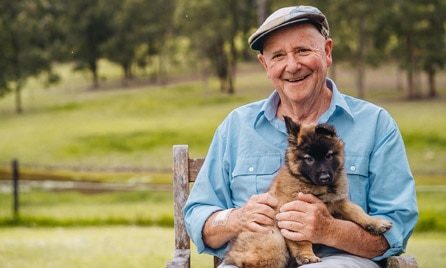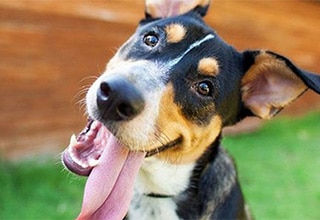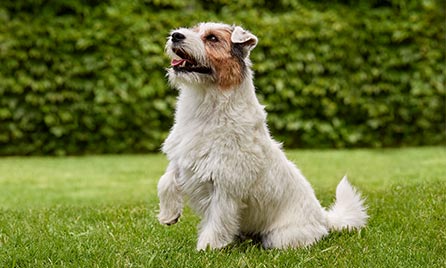- text
-
Dr Harry Cooper (AR No.1000933) is an Authorised Representative of PetSure (Australia) Pty Ltd (AFSL 420183). Any advice provided by Dr Harry Cooper in relation to Everyday Pet Insurance is general only and does not take into account your individual objectives, financial situation or needs.
Hygiene for your dog.
Dr Harry shares his tips and tricks.
Pet Insurance | 6 minute read | 22 January 2025
Dr Harry: Hygiene for your dog.
Hygiene is important to us humans. Just think about how many products are on the market right now to help us maintain our hair, skin, teeth and every other part of our body. You would wonder how we managed before somebody invented soap. We make the effort to take a shower and brush our teeth everyday. It’s a habit and it should be for our four legged friends as well.
Since we live in such close proximity to our dogs, it is essential to maintain our canine companions in the best possible health. Dogs do not tend to look after themselves. They don’t wash, instead they tend to roll in the smelliest mass of whatever in order to make themselves disgusting. Why? Well, it’s a primitive hunting instinct, designed many thousands of years ago when dogs had to fend for themselves. The stench of this material tended to disguise their own doggy smell and made it easier to sneak up on their prey. They don’t have to hunt today, but the habit (much like digging) persists.
How often should you wash your dog?
Most vets would suggest a monthly wash for your dog, but it does depend on just how dirty they get and how cold the weather is. Dog hair and dog skin are quite different from human hair and skin. Coat types vary greatly with the breed. Some shed their coat regularly, like shepherds; others not at all, like poodles. The many designer breeds today are designed to shed little coat, but they still grow!
Supplies you’ll need to wash your dog.
You can tackle the problem yourself using a quality canine shampoo. You’ll also need a conditioner. Flea and tick rinses are a thing of the past. They don’t persist for very long, and spot-ons, tablets and collars are far more efficient. You may even need a medicated shampoo if your four legged friend is suffering from any skin problems, like allergies, or infections. You will also need towels, plenty of warm water, and more than likely, a hair drier. Depending on the size of your dog and the degree of cooperation you get it can take from 10 minutes up to an hour to dry your dog.
How to wash your dog.
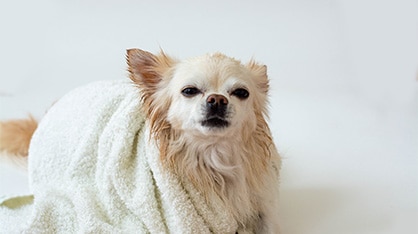
Firstly, we get (and I emphasise the 'we') wet all over. Run a line of shampoo down the back and begin to lather it up with your fingers (gloves optional). Work it down the sides of the chest and abdomen. Then the neck, but be careful around the ears and eyes. It may pay to use a sponge or face cloth. Try to avoid any material getting into the ears. I like to wait 5 minutes, particularly if you are using a medicated shampoo, before rinsing off thoroughly. Follow up with a conditioner in the same manner, then rinse again. It’s important to get rid of all the soapy residue. Most dogs will spend a couple of minutes shaking the excess off before you reach for a towel. If you need to use the hair drier, make sure it is not too hot and keep it moving the whole time.
There are dog washing machines just about everywhere these days, and they do make the job easier. For many of you though, the process will be carried out by a local grooming salon, where your pooch is pampered, clipped, styled, washed etc., and this is no doubt where the name ‘poodle parlour’ originated. It is a 6 to 10 week necessity for many.
A regular wash is your opportunity to check the dog’s skin for any lumps or bumps that may need investigating by your vet. It has another major plus - grooming your dog greatly increases the bond between the two of you.
Clipping your dog’s nails.
What about a nail clip? Not easy, is it? Most dogs intensely dislike it. This is possibly because they were hurt at an earlier stage, when a nail was cut too short. It does hurt. If you compare a dog’s toenail to our own finger nail, they are quite similar. If you squeeze your nail hard, from side to side, it will take the shape of a dog’s nail. We manicure our nails simply by trimming off the clear white part at the tip of the nail. Dogs are no different.
If you need to cut a dog’s nail, make sure you use only top quality canine nail clippers. I try to clip from front to back. If you cut from side to side it squeezes the nail and it hurts. I try to cut in level with the ground. Sometimes dog cutters don’t work. If so, there are other options. Try wrapping a strip of emery tape around your index finger and use it as a file. A metal file is great for bigger dogs. Once they get used to the noise, a dog nail grinder is a great tool, and will grind the nail down. Using something other than cutters does not compress the nail, so there is little if any pain.
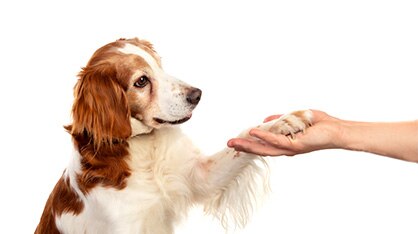
Please be cautious of your pup’s “quick” (blood vessel) in the nail. On the off chance that you cut too far along and the nail bleeds, applying a styptic powder will be the best treatment. If the wound cannot be treated at home, please take your dog to the vet.
It’s a good idea to play with your puppies' feet while they are young. Get them used to having their paws held. This ‘conditioning’ will help. Having said all that, if you aren’t confident in your ability to trim your dog’s nails or if your pup is too fearful, please take them to a professional.
Dog odours.
Bad smells can often be traced to ears, mouth or bowel problems. It pays to check your dog’s ears every time he or she has a bath. Look at the outer ear for signs of fur matting or fly bite irritation, particularly in summer. Look inside the canal and have a sniff. Ear infections, particularly in lop eared dogs, are common. The inner ear may appear red, smell ‘musty’ and have a strong build up of wax. This is a job for your vet. Please don’t go poking things down into the canal. It has a ‘L’ shape, whereas ours is horizontal.
The mouth, or to give it the correct name, the oral cavity, can be a major source of odour. We call it halitosis. Bad breath. 95% of the time it’s due to dental problems - yes, the teeth. What we call plaque, in dogs we call tartar. It is a secretion from saliva that forms large deposits on the teeth, breaks down the gum tooth barrier and leads to infection of the alveolus (socket). This leads to a putrid smell and eventual loss of teeth. When we get to that stage, your vet will step in and take over. In terms of expenses, prevention is better than cure in terms of vets bills. Bones are a great prevention method for your dog’s teeth, but there is a major catch; they must be raw!

Let’s go back in time when dogs had to hunt for their food. It didn’t come as a roll, it didn’t come in a can, it didn’t come in a shiny packet, in fact it required very little chewing. It had to be caught, killed and then torn apart using their teeth. No knives and forks, just teeth, and they ate everything, even the bones. I give my dogs a raw bone at least twice a week and I have never had to clean any of their teeth. They ate them from puppyhood, so their bowels became used to them. If you are going to start now, do it slowly with small amounts and gradually build up. The best bones are brisket, beef if possible. The large ‘bolar bones’ tend to break teeth. Even little dogs with their overcrowded mouths can handle raw chicken bones; just introduce it slowly. Cleaning a dog's teeth is best done by chewing on a bone, not with fancy dental products.
Last but not least on the list is ‘flatus’… a foul smelling fart. This usually reflects an imbalance of bacteria in the lower bowel. It is more common though in those dogs with short faces like the bulldog. Please have a fecal sample checked by your vet for parasites, and if clear, I like to change the diet to white meat and avoid any preservatives.
Keeping your dog healthy and happy is your responsibility. If you are in any doubt please consult your local veterinarian.
Other articles you might like
Get a Pet Insurance quote online today
- text
-
Everyday Pet Insurance policies entered into for the first time prior to 17 July 2023 and subsequent renewals of those policies are issued by The Hollard Insurance Company Pty Ltd ABN 78 090 584 473, AFSL 241436 (Hollard), arranged and administered by PetSure (Australia) Pty Ltd ABN 95 075 949 923, AFSL 420183 (PetSure) and promoted and distributed by Hollard’s Authorised Representative (AR) Woolworths Group Limited ABN 88 000 014 675, AR 245476 (Woolworths). Everyday Pet Insurance policies entered into for the first time on or after 17 July 2023 and subsequent renewals of those policies are issued by PetSure and promoted and distributed by PetSure’s AR, Woolworths. Any advice provided is general only and does not take into account your individual objectives, financial situation or needs. Please consider the Product Disclosure Statement (PDS) to ensure this product meets your needs before purchasing, or choosing to continue with the product. PDS and Target Market Determination available at insurance.everyday.com.au/pet-insurance.

